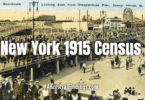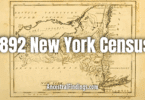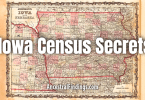The 1880 census is one of my favorite records—not just because of what it tells us, but because of what it helps us feel. This is the first census where we can see families take shape on paper. For the first time, we know how everyone in the household is related to each other. We can watch grandparents living with grown children, sons-in-law starting new farms, and widowed mothers moving in with their daughters. It’s where the people we’ve been tracing start to become real.
When I first found my great-great-grandfather in the 1880 census, I expected just the usual names and ages. But what I saw was a household that stretched across generations—a father who had survived the war, a mother who couldn’t read or write but raised a schoolteacher, and a younger sister I’d never heard of, who later married the farmer down the road. That one census page led me to three new counties, a pension file, and a whole branch of the family I didn’t know existed.
This worksheet is based on that kind of experience. It’s meant to help you look deeper—not just at names, but at stories. Use it to slow down, ask good questions, and notice things you might miss in a quick search.
1. Household Overview
Start with the head of household’s name and location, then write down each person living in the home, along with their age and relationship. Then, take a step back and ask—what kind of household is this? Are there multiple generations under one roof? Do you see a widowed parent or a newly married couple living with their in-laws? I’ve found families where a nephew appears unexpectedly and leads me to the sister who raised him. That kind of clue changes everything. These details might be small, but they shape the bigger picture.
2. Birthplace and Parental Birthplace
One of the best features of the 1880 census is the inclusion of each person’s birthplace and the birthplaces of their mother and father. If you’ve ever been stuck trying to figure out where an ancestor came from, these columns can crack it wide open. A woman born in Ohio with parents born in Virginia and Maryland tells you something about migration. You may find clues to old land claims, war records, or even early church groups that moved together. When I’m stuck on a line, I reread these columns with fresh eyes—they’ve helped me more than once.
3. Occupation and Labor Status
Take time to consider each person’s occupation. Don’t just glance past “farmer” or “laborer”—those were often broad categories. A teenager listed as “works on farm” may have been helping his father, while a “dressmaker” might have taken in work for other families. I once found a relative listed as a teacher in a small town, and by tracking the school, I found a mention of her in local history. Don’t overlook the occupations—sometimes they’re the key to finding your ancestor in other unexpected records.
4. School Attendance and Literacy
This part of the census reveals more than you might think. If a child attended school that year, consider where they went to school. Are there school records, especially in rural or Freedmen’s schools, that might list them? Adults who could not read or write may have left a lighter paper trail or relied on others to handle formal matters. But don’t assume illiteracy means a lack of knowledge—many of these folks were deeply rooted in their communities and passed down oral histories we’re still trying to honor today.
5. Health and Disabilities
I’ve come across notations like “crippled,” “paralyzed,” or “insane since childhood.” It’s heartbreaking but also humanizing. If someone disappears between census years, this might help explain why they did. I once found a man listed as “maimed in war,” which led to a Civil War pension application full of rich detail. If anyone in your ancestor’s household is marked in these columns, it’s worth checking poorhouse records, hospital ledgers, or even newspaper notices.
6. Migration Clues
One of my favorite things to do is trace movement through children’s birthplaces. It’s like laying stepping stones across time. If the oldest child was born in Kentucky, the next in Illinois, and the youngest in Missouri, that tells you exactly where the family was and when. This timeline can guide you to tax rolls, land grants, or even local histories. I once followed a family across three states based solely on these clues and found the land deed that proved their connection.
7. Neighbors and Family Connections
Turn the page forward and backward. Are there familiar names nearby? In-laws, cousins, church members? I once found two brothers living on opposite sides of the same street—one with a slightly different spelling of their surname. They’d both served in the war and returned to buy land near each other. If I hadn’t checked with the neighbors, I might have missed the connection completely. Families often lived in clusters, and clues often hide in plain sight.
8. Putting It All Together
After you’ve worked through the record, stop and take it all in. Does this feel like a stable home or one in transition? Were they starting or rebuilding after hardship? Were they settled or on the move? Every detail—no matter how quiet—adds weight to the story you’re telling. I like to jot down one sentence that sums up what I learned about the household. That summary often sparks my next research step.
9. What to Follow Next
Use the names, places, and occupations you’ve gathered to decide what to search for next. Could this lead to a land purchase? A pension file? A marriage record in another state? Did a new surname show up in the household? This census doesn’t just close a chapter—it opens a dozen new ones. Let it guide your questions and send you in new directions.
Closing Thoughts
I always say the census isn’t just about names—it’s about seeing our ancestors in motion. The 1880 census gives us more than we had before, but only if we slow down and look carefully. I’ve found war veterans, forgotten children, midwives, and ministers all by reading between the lines. So take your time. Study the handwriting. Trace their steps. You’re not just filling in a chart—you’re building a story. And stories are what make family history come alive.






